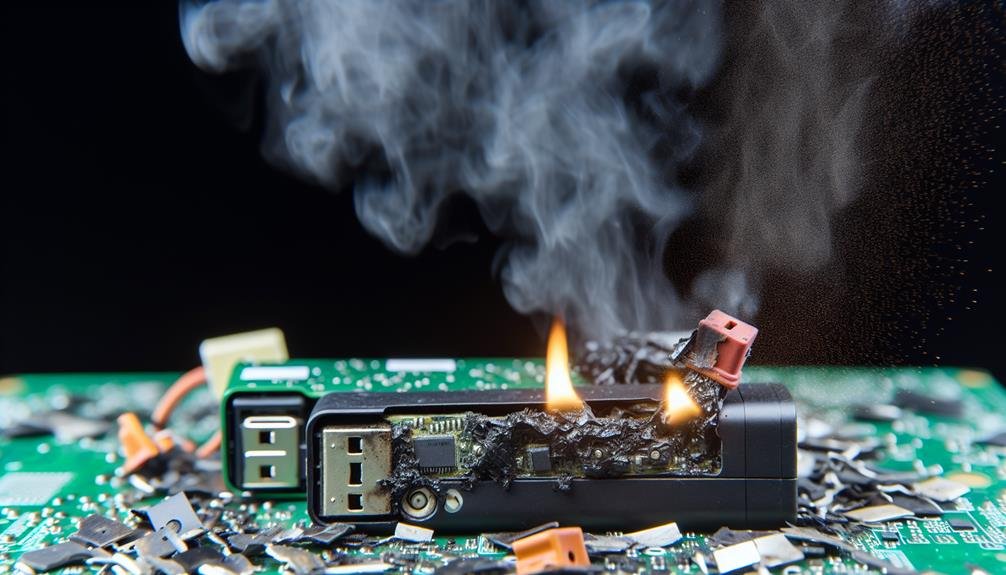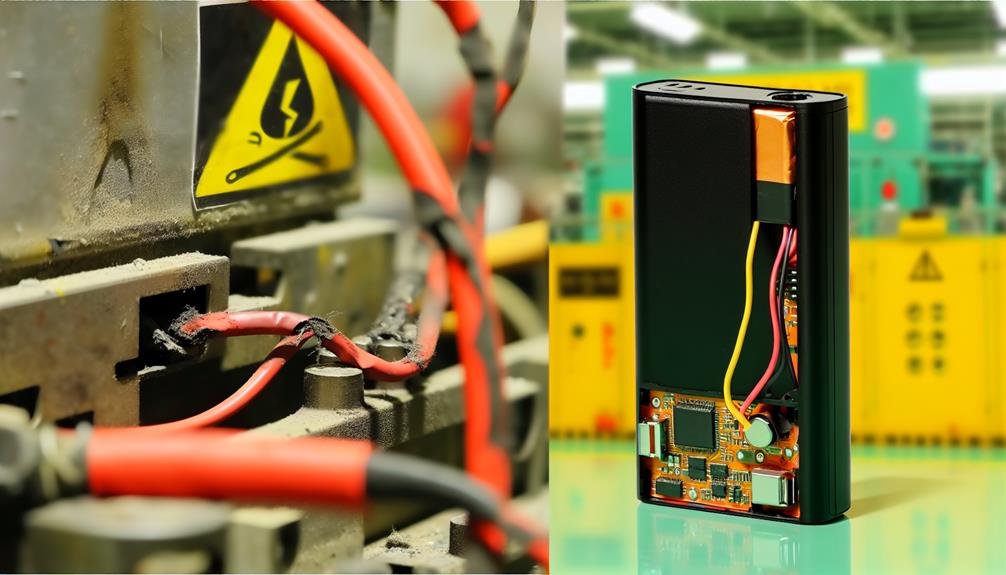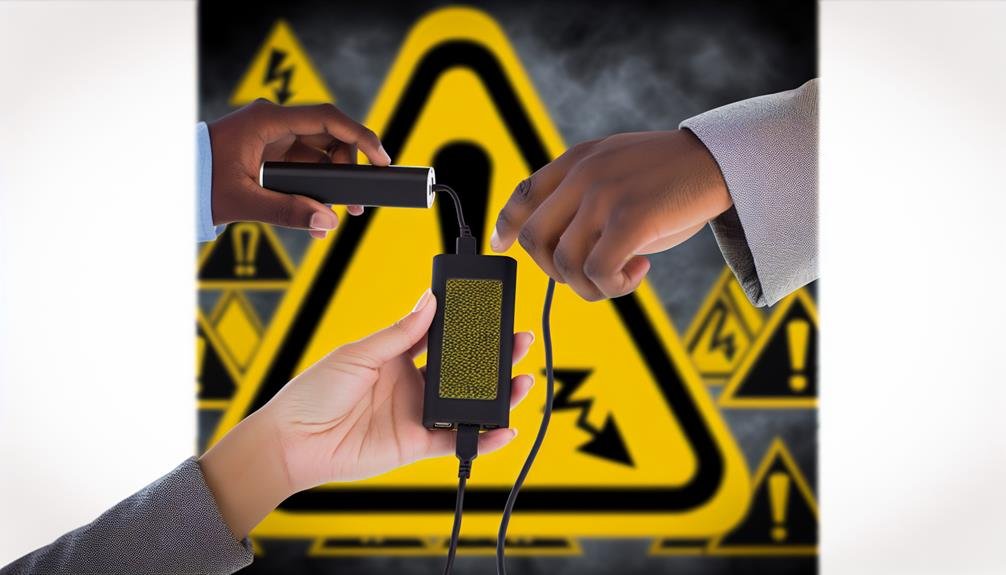Yes, a power bank can explode, especially if it's mishandled. Factors like thermal runaway, improper charging practices, and user misuse can all cause rapid temperature and pressure increases, leading to an explosion. Lithium-ion cells, commonly used in power banks, are sensitive to physical damage, overcharging, and extreme temperatures. Manufacturing and design flaws, such as poor quality control and faulty circuit protection, elevate these risks. Always inspect for swelling, burnt smells, and overheating. Proper usage includes maintaining recommended temperature ranges, avoiding overcharging, and using certified chargers. For a deeper understanding of maintaining safety and efficiency, there's much more to contemplate.
Causes of Power Bank Explosions

One of the primary causes of power bank explosions is thermal runaway, a condition where internal heat generation exceeds the power bank's ability to dissipate heat, leading to a rapid increase in temperature and pressure. When the battery overheats, it can trigger thermal runaway, often due to improper charging practices. For instance, using a charger with incorrect voltage or amperage can cause the battery to overheat, compromising its internal components.
User misuse is another noteworthy factor. If you leave your power bank exposed to high temperatures or direct sunlight, the battery can overheat, increasing the risk of explosion. External damage, such as dropping the power bank, can also lead to internal short circuits. These short circuits can generate excessive heat, pushing the battery into a thermal runaway state.
Maintaining proper usage and charging habits is essential for safety. Always use the charger that came with your power bank or one that meets the manufacturer's specifications. Avoid leaving your power bank in hot environments and inspect it regularly for any signs of damage. By following these precautions, you can notably reduce the risk of a power bank explosion, ensuring safer usage.
Understanding Battery Chemistry
To understand why power banks can explode, it's important to explore the intricacies of battery chemistry, particularly the behaviors of lithium-ion cells under various conditions. Lithium-ion chemistry is popular due to its high energy density and efficiency. However, the same characteristics that make these batteries powerful also introduce several safety concerns.
Battery safety is critical because lithium-ion cells are highly sensitive to physical damage, overcharging, and extreme temperatures. When a lithium-ion cell is compromised, it can enter a state known as thermal runaway. This is a self-sustaining reaction where the battery's temperature rapidly increases, leading to the breakdown of internal components and the release of flammable gases. Thermal runaway is a primary factor contributing to explosion risks in power banks.
Furthermore, the electrolyte within lithium-ion cells is typically a flammable solvent, which exacerbates the danger once thermal runaway initiates. Proper management of charging cycles, usage conditions, and storage environments is crucial to mitigate these risks. By comprehending these detailed aspects of lithium-ion chemistry and the associated hazards, you can take informed steps to ensure battery safety and prevent potential explosions.
Manufacturing and Design Flaws

You must be aware that manufacturing and design flaws can have a profound impact on the safety of power banks. Poor quality control can result in the use of inferior battery components, which increase the risk of thermal runaway. Additionally, faulty circuit protection can fail to prevent overcharging or short-circuiting, leading to potential explosions.
Poor Quality Control
Insufficient quality control during manufacturing can lead to substantial design flaws in power banks, heightening the risk of catastrophic failures such as explosions. When manufacturers don't follow strict quality checks, power banks may suffer from overlooked defects in circuitry, improper assembly, or inadequate insulation. These defects compromise battery safety, posing severe hazards to users.
Conducting a thorough risk assessment is vital for identifying potential failure points in design and assembly. For example, poor soldering can create short circuits, while insufficient thermal management can lead to overheating. Both scenarios significantly escalate the likelihood of an explosion. Additionally, inconsistent quality control can result in the use of subpar materials that fail to meet safety standards.
You should make sure that the power bank you purchase has undergone rigorous quality control procedures. Seek certifications from recognized safety organizations and read reviews that mention the build quality and safety features. Avoiding products from manufacturers with a history of recalls or safety issues is wise. By prioritizing battery safety and conducting a diligent risk assessment, you can greatly reduce the risks associated with poor quality control in power banks. Remember, your safety shouldn't be compromised by substandard manufacturing practices.
Inferior Battery Components
Many power banks become hazardous due to the use of inferior battery components, which often stem from manufacturing and design flaws. When manufacturers cut corners by using subpar materials, the risk of battery malfunction increases notably. Poorly constructed batteries can suffer from internal short circuits, leading to overheating and, in extreme cases, explosions. For improved battery safety, it's important to be aware of the components and materials used in your power bank.
You should also inspect your charging habits closely. Overcharging or using incompatible chargers can worsen the weaknesses in inferior battery components. Modern power banks usually include built-in safeguards to manage charging cycles, but these features can be compromised if the design is flawed or if low-quality materials are employed. Always use the charger recommended by the manufacturer to maintain battery integrity.
When evaluating a power bank, prioritize brands known for rigorous quality control and transparent manufacturing practices. Reliable brands invest in high-quality materials and advanced manufacturing techniques, minimizing the risk associated with inferior battery components. By being vigilant about the quality and design of your power bank, you can greatly enhance battery safety and avoid potential hazards.
Faulty Circuit Protection
Faulty circuit protection in power banks, often due to manufacturing and design flaws, can compromise their safety to a great extent, leading to risks such as overheating or even explosions. When the circuitry responsible for regulating voltage and current fails, it can result in overcharging risks. Overcharging a lithium-ion battery can accelerate degradation and elevate internal temperatures, potentially initiating a thermal runaway event. This is a crucial failure mode where the battery generates excessive heat, causing a chain reaction that can lead to an explosion.
To mitigate these risks, manufacturers must implement robust battery maintenance protocols. High-quality power banks typically incorporate multiple layers of protection, including over-charge, over-discharge, and short-circuit safeguards. However, poorly designed or faulty protection circuits might not reliably prevent these hazards. It's important to select power banks that comply with stringent safety standards and have undergone thorough testing.
Additionally, proper battery maintenance on the user's part is vital. Avoid exposing the power bank to extreme temperatures and inspect it regularly for any signs of damage. By understanding and addressing the technical intricacies of circuit protection, you can greatly reduce the inherent risks associated with lithium-ion safety.
Signs of a Faulty Power Bank
If you notice your power bank swelling, emitting a burnt smell, or overheating during normal use, these are clear indicators that it may be defective and poses potential safety risks. Such symptoms can result from poor charging habits, including overcharging or using incompatible chargers. Improper storage conditions, like exposure to high temperatures or moisture, can also contribute to these issues.
A swollen power bank often indicates internal battery damage, potentially from overcharging or physical impact. The expansion suggests a build-up of gases within the battery, making it prone to rupture. If you detect a burnt smell, it signifies internal short circuits or overheating components, both of which could lead to combustion. Overheating, even during regular use, suggests a malfunctioning temperature control system within the power bank, which is essential for safe operation.
Monitoring these signs is vital for ensuring safety. Always inspect your power bank for physical deformities, unusual smells, and temperature irregularities. Ignoring these warning signs can lead to hazardous situations, including potential fire or explosion. By recognizing these indicators early, you can take appropriate actions to mitigate risks and guarantee safer usage of your power bank.
Safety Tips for Power Bank Use

To ensure your power bank operates safely and efficiently, adhere to best practices such as using it within the recommended temperature range and avoiding overcharging. Best temperature ranges typically fall between 32°F and 113°F (0°C to 45°C). Charging habits play a pivotal role in maintaining safety; always use the original charger or a certified equivalent to prevent voltage inconsistencies that could lead to malfunction or overheating.
It's also essential to monitor the power bank during charging to avoid overcharging, which can degrade battery life and increase the risk of thermal runaway. Never leave your power bank charging unattended for extended periods, especially overnight.
Storage precautions are equally significant. Store your power bank in a cool, dry place, away from direct sunlight or any heat sources. Ensure it's not stored in completely discharged states for long durations, as this can damage the battery cells. Regularly check for any physical damage, such as swelling or leaks, which are indicative of internal issues.
What to Do in an Emergency
In the event of your power bank overheating or showing signs of damage, immediately disconnect it from any devices and move it to a non-flammable surface. This action prevents further risk of ignition or explosion. As part of your emergency response, make sure the power bank is isolated from flammable materials, such as paper, fabric, or wooden surfaces, to lessen fire hazards.
Next, you should ventilate the area by opening windows and doors to disperse any potentially harmful fumes. Avoid handling the power bank excessively to reduce the risk of burns or electric shock. Utilize safety precautions like wearing insulated gloves if you must move the device again.
If the power bank begins to smoke, swell, or emit an unusual odor, evacuate the immediate area and contact emergency services. Provide the operator with detailed information about the situation and follow their instructions meticulously. Risk management is important—never attempt to puncture or dismantle the power bank yourself, as this could worsen the situation.
Frequently Asked Questions
Are Certain Brands of Power Banks Safer Than Others?
When comparing brands, you'll find some are safer due to stringent quality control and robust safety measures. Always check consumer reviews for insights on reliability and adherence to high safety standards during your brand comparison.
Can Extreme Temperatures Affect the Safety of Power Banks?
Extreme temperatures can impact the safety of power banks. Prolonged exposure to high or low temperatures can degrade battery performance and increase risks. Proper storage duration and temperature management are important for maintaining power bank safety.
How Long Can I Safely Store a Power Bank Without Using It?
You can safely store a power bank for up to six months without usage. Beyond this storage duration, battery degradation increases, posing safety risks. Always store in a cool, dry place to minimize these risks.
Is It Safe to Use Power Banks While They Are Charging?
Using power banks while charging can compromise charging safety. It's best to avoid this to maintain battery health. Follow precautions and manufacturer's guidelines to guarantee proper maintenance and prolong the lifespan of your power bank.
What Certifications Should I Look for When Buying a Power Bank?
When purchasing a power bank, make sure it has certifications like UL, CE, or RoHS. These certifications guarantee safety, battery capacity, and charging speed. Don't compromise on these certifications to avoid risks associated with lower standards.



